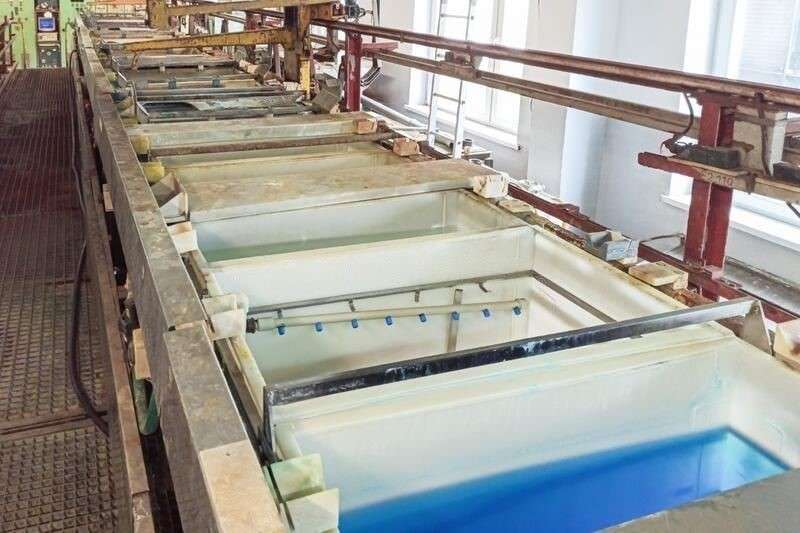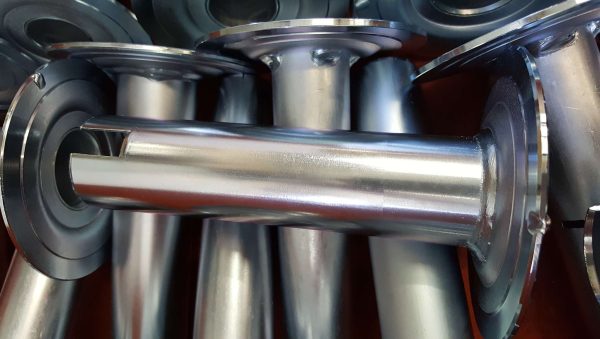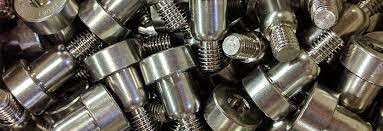
Electroplating Setup
In Electroplating, the coating material deposits on the substrate and develops a thin layer. The deposition takes place by introducing the electric current in the electrolyte depending on the product requirements and specifications. The parts needed to be coated (substrate) serves as a cathode, and the coating material serves as an anode.
1. Zinc plating

Zinc plating refers to applying a thin coating to the surface of parts, leaving a smooth, dull gray appearance. In addition to giving items a great visual appeal, zinc plating makes them corrosion-resistant. The layer of Zinc reacts with the oxygen and forms zinc oxide, which then combines with water to create zinc hydroxide. Finally, the twist happens when a thin coating of zinc carbonate (ZnCO3) is created by the reaction of ambient carbon dioxide and zinc oxide, which adheres to the underlying Zinc and further protects it against corrosion.
2. Silver Plating
Silver plating increases the electrical conductivity and aesthetic appeal of parts. However, a silver coating is quite costly due to the high price of silver. Brass and copper could be the best alternative to silver for Electroplating.
3. Brass Plating
Brass is used in Electroplating mainly for aesthetic purposes. However, it can also serve as a foundation layer for other materials like nickel or Zinc that get plated on top later.
Electroless Plating
In electroless plating, the material is coated without employing the electrolysis process (Electricity). Still, the plating bath with the ions of the plating material is required for the operation. The chemical reaction completes the full plating procedure. When reducing agents like formaldehyde are employed to supply the electron for metal ion reduction, it increases the ion-throwing power in the solution causing the metal ions to be deposited on the surface of the substrate to create a protective layer. Like the electroplating process, electro-less plating begins with cleaning the parts and is treated with various chemical solutions, including buffer solution, complexion agent, stabilizer, and salt solution of the coating metal. Next, the reducing agent initiates the plating process, and metal particles begin adhering to the metal surfaces and forging a solid bond with them.
1. Electroless nickel plating

Parts after electro-less Nickel plating
Electroless nickel plating involves chemically coating a thin nickel layer on a surface of various metals, including aluminum, steel, copper, tungsten, polymer, and many more. Nickel surface coating gives the substrate material a bright look and exceptional hardness, abrasion, wear, and corrosion resistance. The substrate for electro-less nickel plating must be machined with a roughness not exceeding Ra 1.6 µm. The Machining marks will be less noticeable with this method. This process keeps the items’ tolerance within acceptable limits while allowing plating thicknesses of up to 5 microns.
2. Electroless copper plating
To enhance electrical conductivity and aesthetic appeal, copper can also be plated on metallic and non-metallic substrates. Electroless copper plating is also completed by copper salt solution and reducing agent like formaldehyde, similar to nickel.
Common Advantages
The benefits of a plating finish include corrosion resistance, aesthetic appeal, dimensional stability, and many more. Let’s go through some of the benefits in more depth.
A barrier to the external environment
The coating created by Electro-less & Electroplating serves as a barrier against environmental factors, including moisture and gases, and reduces the danger of corrosion, abrasion, and wear.
Enhance the properties
Plating helps with the physical, mechanical, and chemical properties of manufactured parts depending on the type of coating metal. For instance, zinc plating will make substrate components more brittle.
Dimensional stability
The range of plating thickness is 30 micro inches to 500 micro inches. Therefore, the addition of a plating layer will not impact the dimensional stability of the components or products.
Comparison of Different Factors
| Complexity | Electroplating is a more complex surface finishing technique than the electro-less approach. Electroless plating requires filtration equipment, large batteries, a current controller, and other complex setups. While electro-less only involves the chemical treatment process. |
| Thickness of layer | Electroless plating produces a thinner protective layer than Electroplating. |
| Cost | Electroplating is more cost-effective than Electro-less because of chemical heating. |
| Time | Electro-less is faster than Electroplating |
| Material Options | Electroplating is applicable for only electrical conductive material, while Electro-less plating can be done with non-conductive as well. |
Conclusion
Electro & electro-less plating can create a uniform protective layer on the material’s surface. You can choose any process based on the project requirement, dimensional sensitivity of parts, and budget. However, if you’re unsure which to select, ProleanHub can assist you in choosing the best approach. We have Expert engineers with more than 20 years of experience in the industry.




0 Comments